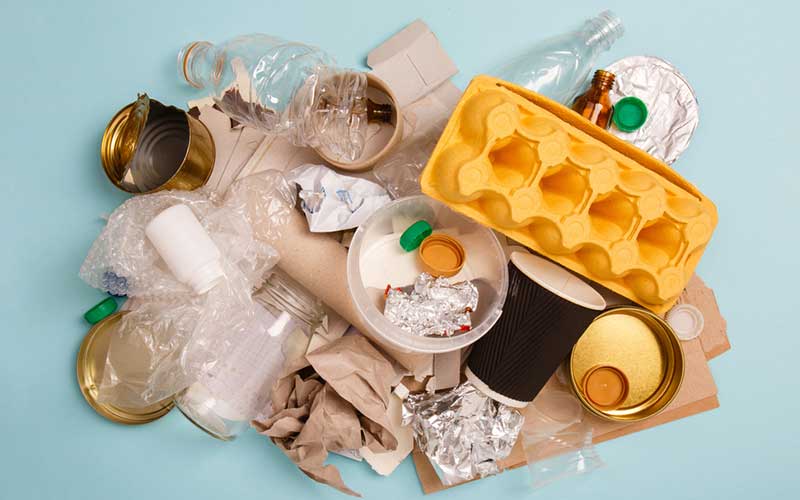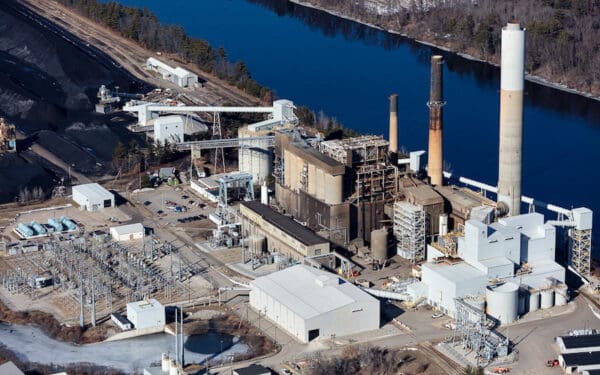
Most packaging material is unrecyclable plastic that inevitably ends up in a landfill or incinerator. Photo: Shutterstock via JasminkaM
A typical trip to the store means leaving with more than I came for. And that’s not just because I can’t say no to a few extra snacks – or pass up a good sale. It’s because everything I buy is needlessly wrapped in layers and layers of packaging. And most of this packaging material is unrecyclable plastic that inevitably ends up in a landfill or incinerator.
What’s frustrating is that, while consumers increasingly want more sustainable options, companies have yet to shed all that excess packaging. Why? The answer is, unsurprisingly, money. Packaging items in plastic is often the cheapest option. But it’s not so cheap when you add in the costs to recycle and dispose of all that packaging – costs that companies don’t pay for. We do.
It’s time we change the script. We can and must hold companies responsible for the waste they create. That’s why CLF is working to pass an innovative new law in every New England state called “producer responsibility for packaging.” We’ve already succeeded in Maine. Now we’re working to create a model for the rest of New England – and the nation – to follow. But we need your help to succeed.
Holding Producers Accountable for Their Waste
Last year, Maine and Oregon passed the first producer responsibility for packaging laws in the country. And now, over a dozen more states are considering similar bills. Under these laws, large corporations that produce single-use packaging will finally have to pay for the cost of managing their waste. Here’s how it works:
- Companies pay fees based on the amount of packaging waste they create.
- That money goes to local governments to reimburse them for the cost of handling packaging waste. It also helps fund recycling infrastructure investments.
As we’ve seen from other producer responsibility programs around the globe, these laws are extremely successful at increasing recycling rates. But requiring companies to pay for the cost of recycling and disposing of their packaging waste is just a start. What we really need is for these companies to rethink how they package their products altogether.
This is an area where producer responsibility for packaging laws can improve. Some programs attempt to incentivize good behavior by lowering the fees companies must pay as long as they make environmentally beneficial changes to their packaging. This means making sure the packaging is 100% recyclable, using post-consumer recycled content, or reducing the toxicity of the plastic used. Unfortunately, these incentives haven’t proven enough to motivate companies to change their packaging design.
What We Need from Producer Responsibility for Packaging Laws
For producer responsibility for packaging programs to be truly impactful, they must require companies to redesign their packaging in a way that reduces waste and benefits the environment. We’ve broken down the five key elements that a modern Producer Responsibility for Packaging Law must have:
- Strong oversight and accountability – A state environmental agency must be responsible for overseeing the program. This includes identifying needs and barriers for waste reduction, reuse, and recycling. It also means setting rules and fees to incentivize better packaging.
- Fees incentivizing better packaging – Brands pay fees based on how hard it is to recycle or reuse their packaging materials. These fees go towards funding reuse and recycling infrastructure and consumer education, as well as compensating cities and towns for recycling costs.
- Requirements to phase out single-use packaging – To cut the amount of single-use packaging companies produce, reduction requirements must be ambitious – and increase over time. Companies can meet these requirements by swapping out single-use packaging for reusable options. These requirements also need to cover the entire range of packaging for each product – from production to final sale. Most Producer Responsibility for Packaging programs only focus on the packaging that consumers throw into residential trash or recycling bins – think milk cartons and chip bags. But this is just the tip of the iceberg. Before we purchase a product, it’s shipped to a retail store or warehouse in even more packaging.
- No loopholes for burning plastic – After reducing their disposable packaging and switching to reusable materials, corporations must make any remaining single-use packaging 100% recyclable. For that to happen, a producer responsibility law must have a clear definition of “recyclable.” That means consumers have access to a recycling system where single-use packaging is collected, processed, and sold for the manufacturing of a new product and not “downcycled.” The definition should not include dangerous plastic-burning technologies like pyrolysis or so-called “advanced recycling.”
- Zero toxics from packaging – Toxic substances in packaging pose a threat to public health and the environment during every phase of the material’s life cycle – production, use, and disposal. We must ban these toxic substances, like PFAS, mercury, and bisphenols, from use. But to truly eliminate all toxic substances from packaging, the law must look forward. That means requiring the state environmental agency overseeing these programs to evaluate new toxic substances in packaging and address emerging chemicals of concern.
We Need to Advocate for the Change We Want to See
While Maine and Oregon are paving the way for other states – and the nation – to hold corporations accountable for their flood of single-use packaging, we have a long way to go to stem that flow for good.
To make a real difference, Producer Responsibility for Packaging laws must include the five key elements listed above. With these comprehensive requirements in place, we can create true systems-level change aimed at reducing waste, redesigning products, and increasing recycling. In turn, we’ll see benefits for our health, our climate, and our environment.
But for all that to happen, we first need to advocate for the change we want to see. Right now, Massachusetts, Rhode Island, and Connecticut are all considering Producer Responsibility for Packaging bills. While some of these bills, like Rhode Island’s, incorporate our five key requirements, others do not. Connecticut’s bill is particularly problematic because it includes a loophole for plastic-burning technology. What’s more, it incorporates almost no accountability or oversight.
We need your help to ensure that every New England state passes a strong producer responsibility bill that will not only hold producers accountable, but protect our communities, environment, and climate. Contact your legislators and urge them to pass a modern Producer Responsibility for Packaging law that includes our five key requirements.


